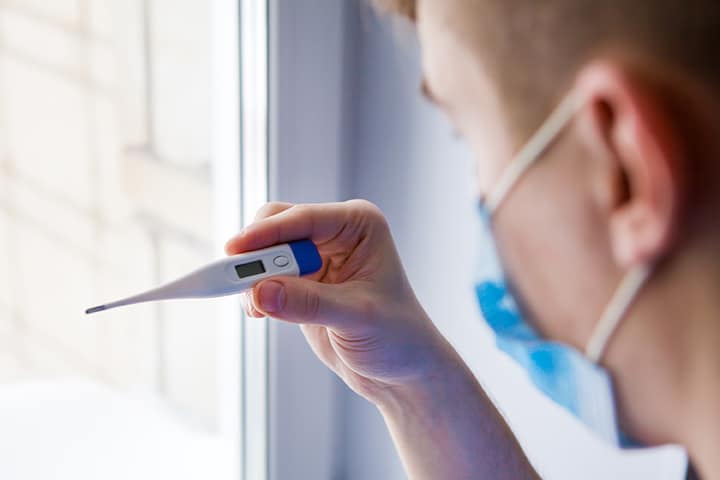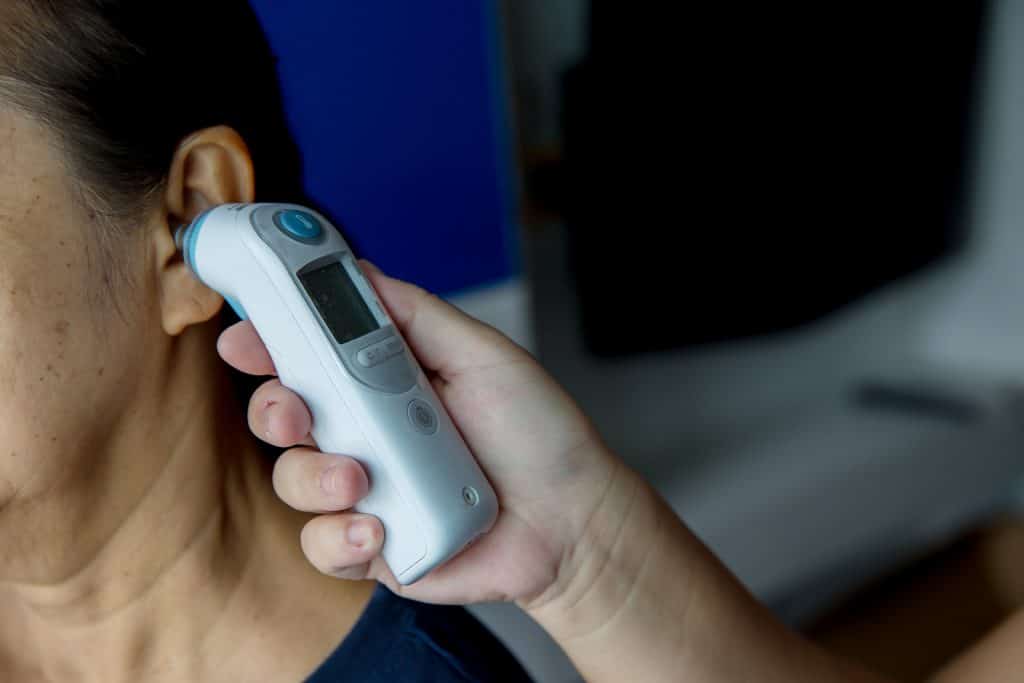How to check body temperature for a fever
- Categories: Health & Wellbeing
Joe Webber
Share this article
How to check a body temerature for a fever
A fever is an unexpected increase in body temperature and is usually a symptom of an illness, including coronavirus. Fevers can cause overheating, cold shivers and in bad cases, hallucinations. The consensus is if you have a temperature over 38.0°C, you have a fever. They usually pass within a few days by themselves, but medication can also bring the temperature down.
Although thermometers provide more accurate results, you can roughly diagnose a fever by hand from feeling the chest or the back, checking for higher than normal temperature. The forehead isn’t a reliable spot to check even though it feels most natural. To be safe, always use a thermometer when you can.
Digital thermometers are the most common type of thermometer and can be bought in pharmacies, supermarkets and online. The recommended testing method for children over five years old and adults is to place them inside the mouth. They can also be placed under the armpit, which is the recommended method for children under the age of five and a useful alternative for adults who can’t have oral examinations. Please always check the instructions of the thermometer before using.

Method 1: The mouth
Firstly, making sure it’s switched off, clean the tip of the thermometer with cold water and soap and rinse well. Turn it on and place the tip under the service user’s tongue towards the back of the mouth. They should close their lips and wait until it beeps or flashes, displaying a temperature.
Method 2: The armpit
You can also use a digital thermometer under your service user’s armpit by instructing them to keep their arm tightly pressed against their body and holding it there until it beeps or flashes. If you’re testing a child under the age of five, it’s important to keep them comfy and stable. It’s recommended you rest them on your knee whilst taking their temperature. For babies and children 36.4°C is considered a normal body temperature and 38.0°C is a high fever.
Method 3: The ear
Ear thermometers are more widely used by health professionals and have a different shape to regular digital thermometers. Their infrared technology and efficiency reflect in their cost, making them a more expensive option. They provide quicker readings but can be inaccurate if not done properly. For the thermometer to work effectively their laser requires clear passage to the ear drum, so it may be necessary to pull the ear back and lift it up to help locate it. Therefore, it can be more difficult to get a correct reading.

Methods to avoid
Glass thermometers are no longer sold in shops or used to measure temperature in humans. The risk of the fragile glass breaking combined with the mercury inside makes it an unsafe and outdated option.
Forehead strips are also available, but they only measure the temperature of the skin and not the internal body temperature, making them an ineffective choice for diagnosing a fever.
Getting accurate results
Thermometers read the internal temperature of the body, so anything that naturally makes you warmer, like taking a hot bath, wearing lots of clothes or blankets, hot water bottles or hot drinks, or being active will naturally increase your body temperature. While it’s important to follow the readings of a thermometer in all circumstances, regular testing should be carried out throughout the day as the body temperature fluctuates.
What should you do if a resident has a fever?
As mentioned previously, fevers usually go away on their own after a few days but as they are also a common symptom of COVID-19, action should be taken as soon as possible. Another key symptom to look out for is a new continuous cough. If your Service User shows signs of either symptom, it’s important to follow protocol and place them into isolation, using protective equipment if available.
Currently, the government guidelines state if you have a single Service User with symptoms, contact the NHS by phoning 111 (or visit their online 111 service) for instructions on what action you should take. Alternatively, follow any local instructions specific to your care home if you have them.
If you have more than one Service User with symptoms, also inform the Health Protection Team (HPT) so they can arrange next steps.
A fever can be a symptom of various illnesses, not only coronavirus, but following the appropriate steps will give you more indication on what the underlying problem may be and the best way to cope with them.
Recording temperature on CareDocs
In CareDocs, we have developed a dedicated Charts section for each resident which includes a Temperature chart and a NEWS2 chart. Using these, you can record temperature changes and the CareDocs system will automatically add these to a monitoring sheet. You can also detail any concerns about a resident’s health in digital daily care notes. If there are any concerns, you can set appropriate monitoring alerts to remind you to keep checking.
CareDocs Local customers can also add temperature readings via CareDocs Mobile. CareDocs Cloud customers can add and view temperatures via CareDocs Cloud Portal.
If you would like to find out more about how our person-centred care software can support the safety of your residents, phone 0330 056 333 or email sales@caredocs.co.uk to speak to our friendly team.
Sources
NHS 111 online service: https://111.nhs.uk/covid-19/
Health Protection Team (England): https://www.gov.uk/health-protection-team
Government Guidance for Admission and Care of Residents During COVID-19 Incident in a Care Home: https://www.gov.uk/government/publications/coronavirus-covid-19-admission-and-care-of-people-in-care-homes
Share this article
Author
Joe Webber
Search
Recent articles
- CareDocs Partners with the Professional Record Standards Body (PRSB) to Support Care Standards Fit for the Future of Digital Care January 30, 2024
- CareDocs Joins the Care Software Providers Association (CASPA), an Independent, Not for Profit Association, Representing Software in the Care Industry January 19, 2024
- CareDocs partners with Bristol Waste to tackle digital poverty January 10, 2024
Recent comments
- 1.2. Assess use of care plans in applying person-centered values - CIPD Writers on What is person centred care planning and why is it important?
- Call tracking tips for care home marketers - Chester Times on The importance of effective communication in care
- Why is effective communication important for positive relationships with individuals in care? - Building-Craft on The importance of effective communication in care











